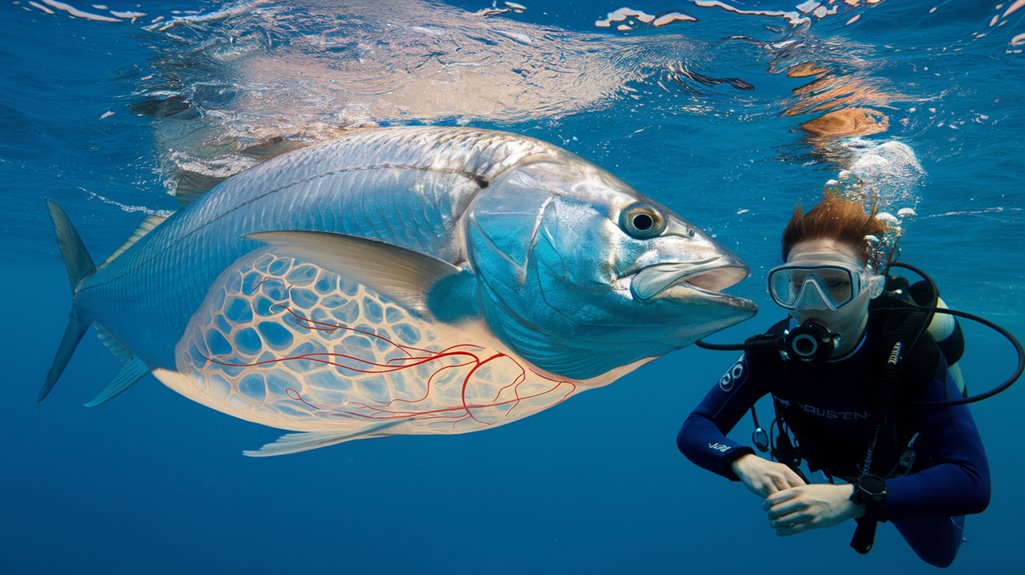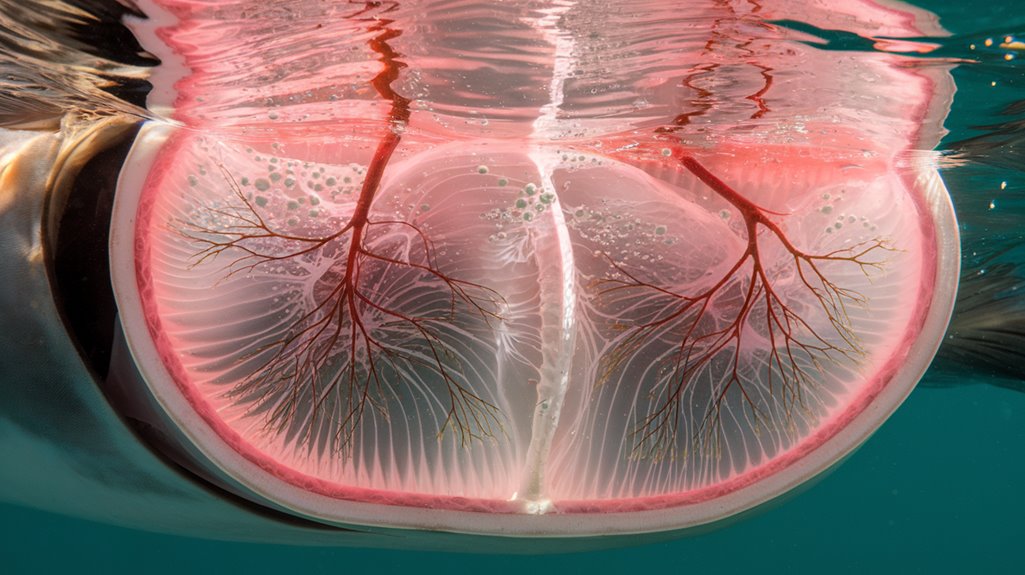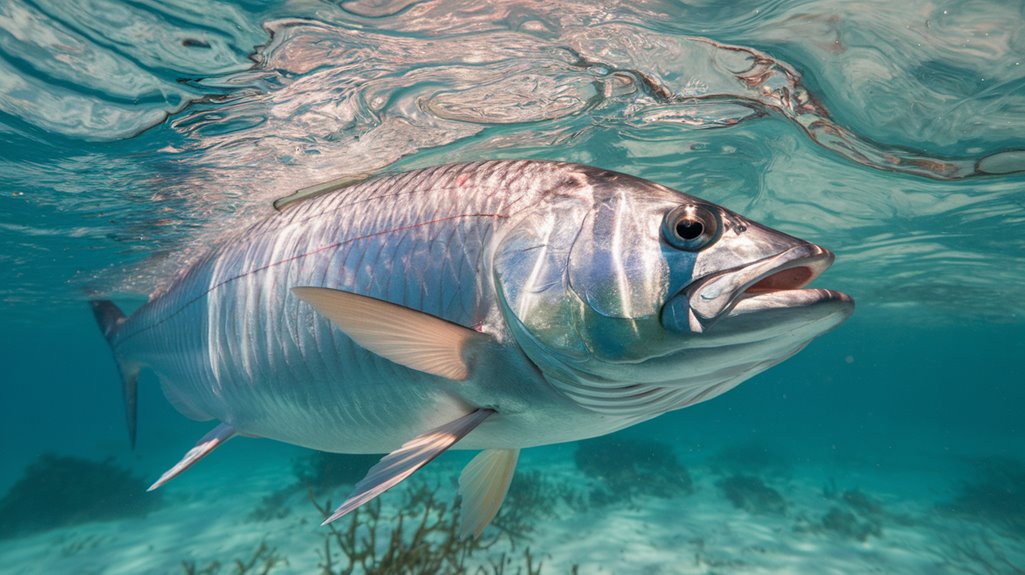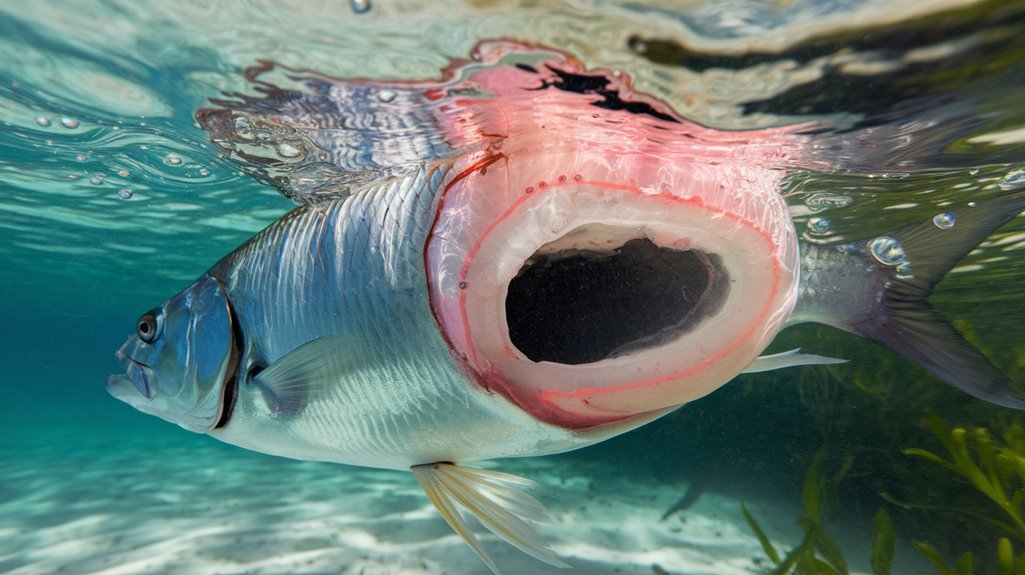You'll find that the tarpon's swim bladder represents one of nature's most sophisticated buoyancy systems. This specialized organ enables these fish to maintain precise depth control through a complex network of blood vessels and gas-permeable membranes. As you examine its structure, you'll discover how tarpons can shift from surface waters to deeper zones with minimal energy expenditure, while other fish species struggle with such shifts. The mechanism behind this remarkable adaptation holds several surprising features.
Key Takeaways
- Tarpon's swim bladder achieves perfect neutral buoyancy through active gas regulation, allowing effortless hovering in water without energy waste.
- The swim bladder connects directly to the esophagus, enabling tarpons to gulp surface air for enhanced buoyancy control.
- Highly vascularized bladder walls facilitate rapid gas exchange with bloodstream, enabling quick adaptation to changing water depths.
- The flexible bladder structure responds to pressure changes following Boyle's law, maintaining stability during vertical movements.
- Specialized tissue and blood vessel networks allow precise buoyancy adjustments for both slow hovering and high-speed pursuits.
The Engineering Marvel of Tarpon Buoyancy

While many fish species possess swim bladders, the tarpon's specialized version stands as a masterpiece of biological engineering. You'll find that this remarkable organ allows the fish to achieve perfect neutral buoyancy without wasting energy, making it possible for them to hover motionless in the water column. The swim bladder's extraordinary ability to expand and contract enables tarpons to adapt swiftly to varying depths and pressure changes they encounter.
What's particularly impressive is how they can actively regulate their buoyancy by transferring gas from their bloodstream into their swim bladder. This precision control system proves essential during their high-speed pursuits and spectacular aerial displays, where they can reach speeds of 35 miles per hour. The swim bladder's efficiency directly contributes to their reputation as one of the ocean's most accomplished swimmers.
Anatomy and Structure of the Swim Bladder
A complex network of blood vessels and specialized tissue forms the foundation of a tarpon's swim bladder, creating a remarkably efficient gas exchange system. You'll find that this remarkable organ features a thin, flexible wall that responds to pressure changes according to Boyle's law, enabling precise buoyancy control. The swim bladder's direct connection to the esophagus allows tarpons to gulp surface air, supplementing their gas requirements.
- Highly vascularized walls facilitate rapid gas exchange with bloodstream
- Elastic membrane walls expand and contract with depth changes
- Specialized connection to esophagus for surface air intake
- Dense capillary network for efficient gas secretion and absorption
- Pressure-responsive tissue structure that follows physical gas laws
These anatomical features work in concert to maintain neutral buoyancy, allowing tarpons to conserve energy while maneuvering through various depths.
Gas Exchange Mechanisms in Tarpons

Building upon the structural features of the swim bladder, the gas exchange mechanisms in tarpons represent an impressive adaptation that sets them apart from many other fish species. You'll find their highly vascularized swim bladder functions as a supplementary respiratory organ, enabling oxygen extraction directly from the water, similar to gills.
What makes tarpons uniquely efficient is their ability to swim to the surface and gulp air, which enters their swim bladder through a connection to their esophagus. This direct gas exchange system allows them to regulate buoyancy with precision and survive in oxygen-depleted environments. The efficiency of their gas exchange mechanism supports their active lifestyle, even at depths where oxygen availability is limited, demonstrating why tarpons have successfully adapted to diverse aquatic habitats.
Depth Adaptation and Pressure Response
Through their sophisticated swim bladder mechanisms, tarpons demonstrate remarkable pressure tolerance and depth adaptability in diverse aquatic environments. As these bony fish move through different water depths, they expertly regulate their buoyancy by adjusting gas volumes within their swim bladder. You'll find that their direct connection between the swim bladder and digestive tract enables precise control over gas exchange, letting them swallow air or release it as needed.
- Rapid vertical movements between surface waters and depths exceeding 100 feet
- Instantaneous pressure compensation through gas regulation
- Energy-efficient buoyancy adjustments during depth changes
- Seamless shifts between shallow estuaries and deep waters
- Strategic gas exchange for maintaining neutral buoyancy under varying pressures
Their swim bladder's adaptive capabilities make tarpons highly efficient predators across their habitat range.
Environmental Impacts on Bladder Function

While tarpons maintain sophisticated control over their swim bladder function, environmental conditions greatly influence their buoyancy regulation mechanisms. You'll find that temperature variations considerably affect gas solubility within their swim bladders, forcing these fish to adjust their buoyancy strategies constantly.
| Environmental Factor | Impact on Swim Bladder |
|---|---|
| Temperature | Alters gas solubility rates |
| Water Pressure | Changes bladder volume |
| Salinity | Affects gas exchange efficiency |
| Pollution | Reduces available dissolved gases |
| Seasonal Changes | Modifies buoyancy requirements |
The tarpon's ability to maintain neutral buoyancy becomes particularly challenging when faced with reduced oxygen levels in warmer waters. They'll need to perform more frequent gas exchanges to compensate for these environmental stressors. During seasonal changes, you'll observe these fish adapting their swim bladder function to match shifting habitat conditions.
Frequently Asked Questions
How Does the Swim Bladder Control Buoyancy?
Your swim bladder controls buoyancy by secreting or absorbing gas through blood capillaries in the gas gland, adjusting volume according to Boyle's law while maintaining neutral buoyancy at varying depths.
What Is the Fastest Way to Cure a Swim Bladder?
You'll need to adjust water temperature and add Epsom salt to regulate gas. Support your fish with a net while providing easily digestible food and maintaining ideal water quality.
What Is the Air Bladder for Buoyancy?
You'll find the air bladder is an internal gas-filled organ that helps fish control their vertical position by adjusting internal gas volume to match surrounding water density, enabling neutral buoyancy.
What Is the Significance of the Swim Bladder?
You'll find that the swim bladder's significance lies in its control of buoyancy, enabling efficient energy use, sound detection, and pressure regulation while helping fish maintain position at varying depths.
Conclusion
You've now explored the intricate mechanics of the tarpon's swim bladder, a masterpiece of biological engineering. Through its sophisticated gas exchange system and pressure-responsive structure, you can observe how this organ enables precise buoyancy control. As you've learned, the bladder's adaptive capabilities directly influence the tarpon's survival across varying depths and oxygen conditions, demonstrating nature's solution to complex physiological challenges.

